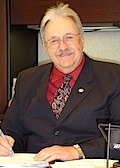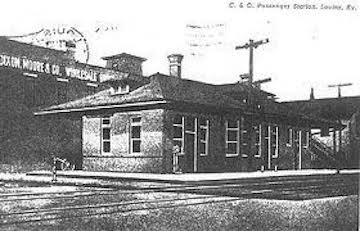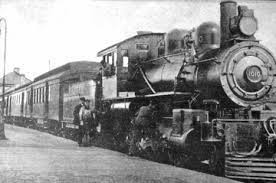 Growing up in Louisa…by Michael Coburn
Growing up in Louisa…by Michael Coburn
Missing the Depot
Back when I was but a youngster the roads and highways were not much. I was used to seeing deep mud holes and ruts that would entrap our vehicles until a kind farmer would hitch up a team of horses, or a tractor, to pull us out. Often corduroy roads were layered over creeks and bogs of backroads as we waited for bridges or culverts to be built. To get to locations either north or south there was only a very few paved, two lane roads. Those wound through the steep foothills, often taking us miles away before turning back toward our traveling goal. For many who didn’t have a car the bus was the choice. These had no air conditioning (unheard of) and travelled up and down the ‘horseshoe’ mountains and down in the hollows in between.

The easiest way to travel was to buy a ticket at the depot and wait for a south or north bound passenger train. Train travel was a great deal more pleasant than those early bus memories I have. The passenger train we caught at the depot stopped at all of the little whistle stops down river. I can’t remember all the names but some I think were Potters, Zelda and Buchannan. A couple up river stops that I never visited were Whitehouse, Richardson and Peach Orchard. My great grandmother lived in those communities before to Louisa. Over time when riding the rails I got to meet know folks from up and down the line. A few commuted to attend school at good ole LHS and were classmates. The river road leading north wasn’t paved and was impassible during muddy seasons. There were no bridges or culverts over the several creeks. This highway was finally opened during my senior year in high school, so catching a train wasn’t the best method for going to school. Those big, yellow buses did the job. I’m sure the train was the best way to town if the school bus was missed and the parents couldn’t bring them.
When I was growing up, my mom and I caught the train at the Louisa depot going north, or downriver. I remember the two waiting rooms that were separated by the ticket office and baggage claim. The waiting room had big oak benches I loved to use. When mom wasn’t looking I would slid up and down until more passengers began to fill up the room. I remember the penny gum machine that mom usually tried to steer me away from. I think even pennies were scarce, but mom also thought the gum was bad for me.
Just out the back of the station there were several big wooden baggage wagons that had large steel wheels. They were painted the usual ‘olive drab’ and had the C&O logo. When the wagon was pulled out next to the baggage car the man could easily transfer the packages and ‘grips,’ or suitcases into the baggage car. While in the station the engineer walked the length of the train looking at the undercarriage of the cars. He had an oil can to lubricate the big drive pistons on the engine or whenever he saw a squirt of oil was needed. The train conductor, all decked out in his uniform with shinny buttons mounted the platform step, cupped his hands and hollered “All aboard.” When boarding was done he pulled the boarding step aboard and waved his lantern at the engineer. The train began to move slowly at first. Sometimes the big drive wheels would spun when trying to gain traction. The big engine pushed out great clouds of steam. Finally, the wheels got a good grip on the slick tracks and the engine pulled the cars out of the station. I remember a few times when some of us boys put a penny on the tracks just ahead of the engine. After the train left we ran to the spot to find our flattened coin.
All trains in those days had cabooses. On freight trains they were often red and had a little raised roof midway for the worker to see out. I understand that he had communication with the engineer and could signal if anything went amiss. The engineer was tasked with watching the tracks ahead for danger. Trains were self-steering, but the tracks sometimes became misaligned because of rock slides or other phenomenon. If trouble was spotted the engineer tried to bring the locomotive to a stop, a feat not easy or fast. Momentum and the weight of the train made it difficult for the wheels to grab the steel tracks firmly.

Often, men were sent from one station to another on hand carts which were propelled by pumping a handle up and down. Two men pumping could make really good time. The little car was light enough that the two could easily take it off the track to allow the trains to pass. These men threw switches, which are now handled electronically from perhaps as far away as Atlanta, or some other remote station.
I had a great grandfather that was a train conductor. He died a long time before I was born, but the position was considered a coveted and honorable one. I’m told he wore the navy blue uniform with the brass buttons, pocket watch, and the small pill-box hat with slight brim. It was a sharp look and very official. The passenger cars in the old days were crowded with friendly working people commuting to or from their jobs. I had an Uncle that was a design engineer who helped draw plans for bridges, tunnels and other features of the network of rails. He was involved with drawing the Chessie logo, too, I was told. I saw some sketches of the sleeping kitten at his house. He had a great talent for drawing.
I’ll never forget the sound of click-click, click-click as the steel wheels hit the seams in the rails. There was a swaying and rocking and a bit of an up-down movement as the rails sank under the weight of the cars. You didn’t have to be on-board to hear the sounds, but the sway was only noticeable to those on board.
The engineer had to hang his head out of the window to see past the big boiler. He was always looking for problems with the track or anything that might block it. Red and green lights told the engineer if the tracks ahead were clear. Sometimes when a track was a single line, the train was diverted to a side-track to allow another train to pass safely. When two passenger trains passed, usually in a station or near one, it was interesting to look at the passengers on the other train. Usually the cars were well lit, making it all seem like an old-time silent motion picture.
You could smell the thick smoke and feel an occasional cinder hitting you on the cheek. This was especially true if you were in an open car or between cars when the doors were open. The sound of the whistle was something never to be forgotten. Johnny Cash and others memorialized it in song, but it was already a major part of America. Trains were the first arteries after the rivers for the young nation. It took until after World War II before the highways were improved sufficiently to support the ‘big rigs’ that began to take business from the railroads.
While the train stopped at the Louisa depot it dropped and picked up mail as well as newspapers, magazines and merchandise for Erns and Hacks newsstands, for resale. At the small whistle stops mail was picked up while still at full speed by use of a big hook that grabbed mailbags hung on a device as the train rushed by. That was fun to watch and in some ways a little scary, it happened so quickly.
During eighth grade I lived in Detroit and often rode the trolleys. They were cheaper to run, less disruptive to traffic and were loved by the public. Strong lobbies of the automotive industry and the gasoline industry, led the cities across the nation to replace trolleys with buses. It was sad to see the changes as the thick diesel smoke filled the air and horns blared. San Francisco, Portland, and Atlanta are some major cities that kept their trolleys. I suspect there are others. Today we are seeing light rail across the nation being touted as the ‘green’ solution to our traffic problems. No doubt that today’s light rail is faster than trolleys, but in many cities the old rails are buried under several feet of blacktop since it was easier to bury them than to take them up.
So, train service was easier and faster and way more comfortable than riding those early buses. Today’s trains are even better and operate, in part, by computers. Visibility of the tracks for the engineers is much improved. Logistics has become more of a matter of science rather than having to put signalmen all along the rails. The railroads are still one of the major landowners in America. Business is tough because of laws relating to interstate commerce and antitrust issues. In addition, trucks can carry loads directly to most any address while rails were limited. In the beginning, trains made many men rich. Some were exceedingly wealthy. Maybe we’ll see a return of rail usage, but the problem is that every guy has tasted the freedom of riding his own horse. We love the highways and giving up those freedoms will not come easily.
Sadly, our little depot burned. It’s been years but I still miss seeing it. I have my memories as do many others.













![Foothills-Bundle] Foothills-Bundle](https://thelevisalazer.com/wp-content/uploads/2020/05/Foothills-Bundle-422x74.jpg)





Fond memories. We lived on N. Jefferson St. with only the street between our house and the tracks. Those trains rocked us to sleep every night. We rode the train to Brooklyn, New York and Washington DC when I was 12. My stepdad was Max Smith and he was a welding forman for C&O . After he retired he went to the depot every day just to talk to old friends. He and Peewee Marcum timed all the trains.
Thanks for the memory. Train tracks were right outside my paternal grandmother’s front yard out in the country. When we visited, the sound of the train blowing its whistle and rattling around the bend on the tracks would keep us awake at night. Then after a few nights, we got used to the sound and would sleep through it.
Lovely memories of a happy childhood time.